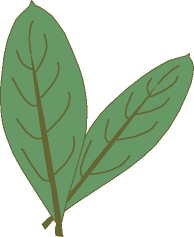

The bay tree (Laurus nobilis) is an evergreen tree/shrub native to Asia Minor and the Mediterranean region. It is also known as sweet bay, bay laurel, noble laurel, and true laurel. Early Greeks and Romans attributed magical properties to the laurel leaf.Bay leaf is also an essential ingredient (along with parsley and thyme) in a bouquet garni. To make a bouquet garni, tie together a bay leaf, parsley, and thyme (and any other desired herbs) or place in cheese cloth and tie. The bouquet garni is cooked with a stew or sauce and removed before serving.Bay leaves are often used in dishes that require slow cooking, such as stocks, soups, stews, pasta sauces, casseroles, pickling spice mixtures, and seafood boil spice mixtures. It's pungent quality is best in moderation; overuse of bay leaves can make foods bitter. Bay leaves should always be removed from dishes before serving to prevent people from accidently eating them.
Tip of the month: Before baking potatoes, cut a slit in each potato and put in a bay leaf. Bake as you normally do.